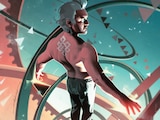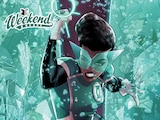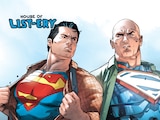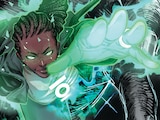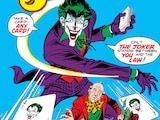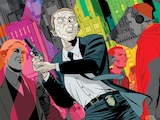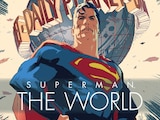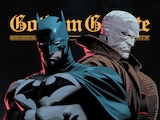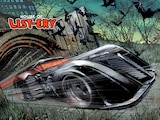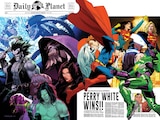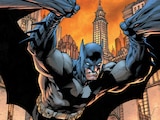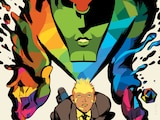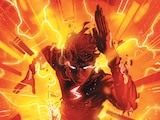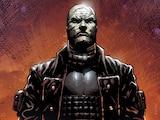This weekend, people across the country will be celebrating Thanksgiving, but it’s important to remember that it isn’t the only holiday at the end of November. Since 2008, the Friday after Thanksgiving has been officially recognized as Native American Heritage Day in the United States of America. On this day, we are all encouraged to take some time and examine the impact, history and culture of the hundreds of native nations who continue to inhabit this land. After all, any depiction of America without recognition of its native people would be woefully incomplete.
The same could be said about the DC Universe. While they may not all have the name recognition they deserve, a great number of Native American heroes from across many diverse, unique nations have emerged to fight for the cause of justice in the pages of DC comic books. So, in recognition of this, we’ve put together this list celebrating twenty of the greatest Native American superheroes you can find within the DCU.

Ohiyesa “Pow-Wow” Smith
Nation: Sioux
First Appearance: Detective Comics #151, 1949
Recommended Reading: Robin Annual #6
Ohiyesa Smith was created as a clever inversion of the commonly seen trope of a white settler embedding himself in a Native tribe. Rather, this early comic book hero was Sioux, laying down the law as an unlikely U.S. Marshal who had to fight for respect at every turn. Years later, Tim Drake would meet up with Smith’s descendant, still following in his ancestor’s footsteps, to pursue the Trigger Twins into Gotham Gulch.

Man-of-Bats and Raven Red
Nation: Lakota
First Appearance: Batman #86, 1954
Recommended Reading: Batman Incorporated (2022)
A US war veteran, Man-of-Bats has been seen patrolling the Dakota plains since joining Batman’s “Club of Heroes” in the 1950s, along with his son and sidekick, Little Raven. Years later, a grown Little Raven, now operating under the name Raven Red (above), would represent his father in joining the ranks of Batman Incorporated. Today, both heroes remain with Batman Inc, serving together under the unlikely leadership of Ghost-Maker as featured in the latest twelve-issue Batman Incorporated series.

Brave Bow
Nation: Sioux/Navajo
First Appearance: Adventure Comics #262, 1959
Recommended Reading: Secret Origins #38
Brave Bow is a Native American chieftain who may have never fought crime directly, but played an essential role in the history of the Arrow family. Though referred to as Sioux in early appearances, later issues more reliably depicted him as a Navajo chief. Brave Bow was close friends with Roy Harper Sr., an Arizona forest ranger who was killed in the line of duty when his son, Roy Jr., was only three. Brave Bow took in young Roy Harper and raised him as his own—and while this has never been confirmed, many speculate that Roy’s mother may have originally been Navajo herself. It was with this family that Roy Harper learned to master archery, preparing him for the vigilante lifestyle with his future mentor Oliver Queen.

The Navajo Ace (Johnny Cloud)
Nation: Navajo
First Appearance: All-American Men of War #82, 1960
Recommended Reading: Superman #8 (2016)
Johnny Cloud was a high-flying member of the Losers, a hard luck troop that fought impossible odds behind enemy lines throughout Europe in World War II. Despite a lifetime of racial prejudice, Johnny Cloud rose through the ranks of the military to become one of the most respected and renowned combat pilots of his time. When flying into action, Johnny Cloud’s arrival was often symbolically heralded by the image of a stallion in the clouds—a sign that the Ace would soon be here to bail out his brothers-in-arms from certain doom.

Super-Chief
Nation: Iroquois
First Appearance: All-Star Western #117, 1961
Recommended Reading: 52 #22-24
Canonically speaking, Super-Chief isn’t just a Native American superhero…he’s the FIRST American superhero. Dating back long before the arrival of Columbus, the title of Super-Chief was a mantle handed down from father to son to protect the Five Nations of Iroquois, with the assistance of the mystical Manitou Stone. The bearer of the Manitou Stone was imbued with “the strength of a thousand bears,” “speed that surpasses the fastest of deer,” and “jumping prowess that surpasses those of the wolf.” (Although it should be noted that “Manitou” is an Algonquian word, not Iroquois.) The tradition of the Super-Chief continued into the modern day, where its bearer Jon Standing Bear used its abilities to participate in an interim incarnation of the Justice League of America.

Little Sure Shot (Louis Kiyahani)
Nation: Apache
First Appearance: Our Army at War #127, 1962
Recommended Reading: Sgt. Rock: The Prophecy
Louis Kiyahani hustled through the trenches as a member of Sergeant Rock’s legendary Easy Company, taking on the toughest challenges the Axis had to offer as the company’s designated crackshot sniper. Like many members of Easy Company, Kiyahani distinguished himself with a particular affectation—in his case, affixing red and white plumes of feathers to the side of his helmet. He was eventually succeeded by his grandson, Chad Kiyahani, as a member of the extraterrestrial and supernatural battling Human Defense Corps.

Apache Chief (Tye Longshadow)
Nation: Apache
First Appearance: Super Friends, “The Antidote” (1977)
Recommended Viewing: Young Justice: Invasion
Perhaps the most famous of all Native American superheroes, Apache Chief was one of several characters designed to diversify the ranks of TV’s Super Friends. With a cry of “inukchuk”—a rather incongruous reference to the giant “inuksuk” figures sculpted by Canadian First Nation peoples—Apache Chief was able to grow to tremendous heights, often squaring off against his Legion of Doom counterpart, Giganta. Years later, Apache Chief was reintroduced in Young Justice as Tye Longshadow, a conflicted teenage Apache coming to terms with his metahuman powers, and close friend to Blue Beetle, Jaime Reyes.

Owlwoman
Nation: Cherokee
First Appearance: Super Friends #7, 1977
Recommended Reading: Justice League Europe #2-4
Before the rise of Justice League International, the first globalized super-team was the Global Guardians. Each member of the Guardians represented a different nation, with the USA represented by Owlwoman: a Native American woman from Oklahoma with the power of flight. Sometimes seen as an ally to Hawkman and Hawkwoman, Owlwoman was involved in a romantic relationship with the Irish Global Guardian, Jack O’Lantern.

Dawnstar
Nation: Ancestral Puebloan
First Appearance: Superboy and the Legion of Super-Heroes #226, 1977
Recommended Reading: Legion Lost (2011)
An ancient Native American group and forerunners to the modern Pueblo, Dawnstar’s people disappeared from America long ago. In Legion of Super-Heroes, we learn that Dawnstar’s people were abducted from Earth in the 13th century and migrated to the far-off planet of Starhaven. In the 31st century, Dawnstar represents her people as a member of the Legion of Super-Heroes where she stands as the greatest tracker in the known universe. Her powers allow her to travel unaided through space at faster-than-light speeds and follow trails across light years of distance.

Hawkman
Nation: Navajo
First Appearance: Flash Comics #1, 1940
Recommended Reading: Hawkman (1993)
Continuously reincarnating through time and space, Hawkman is a man who has lived lives beyond counting. In the 1993 Hawkman series by John Ostrander, we learn of an important connection between one of the lives of Hawkman and the Navajo people—that the Thanagarian Katar Hol’s mother was in fact a Navajo medicine woman who took an extraterrestrial lover. Through a newfound respect and connection to Navajo traditions, Hawkman achieves greater harmony with his powers and abilities on a spiritual plane, allowing him to vanquish foes once beyond his reach.

Rainmaker
Nation: Apache
First Appearance: StormWatch #8, 1994
Recommended Reading: The Movement
Sarah Rainmaker is a weather-manipulating member of Gen13, a group of metahumans struggling with their powers and hormones as WildStorm’s premier team of teenage heroes. Rainmaker’s interests include flying, social justice and an unrequited crush on her team leader, Caitlyn Fairchild. Eventually, Rainmaker was incorporated into the DCU proper in The Movement, where she once again fraternized with her team leader, Virtue. Although this time around, she’ll have better success.

Seneca
Nation: Seneca Iroquois
First Appearance: Justice League International #63, 1994
Recommended Reading: Justice League International #63-66
Possessing immense physical strength, Seneca was one of a number of heroes from marginalized communities who were duped into joining the cause of the Immortal against the Justice League International. Realizing that he was once again being exploited, Seneca eventually turned against his posturing savior to fight him alongside the Justice League. Seneca’s true identity and current whereabouts are unknown, but he surely must be out there somewhere continuing to fight the good fight.

Chindi
Nation: Navajo
First Appearance: Steel #17, 1995
Recommended Reading: Steel #17-19
Russell Wolf was a flying, force field-projecting Navajo hero, who dedicated himself to pursuing John Henry Irons for the weapons of mass destruction he helped design before leaving that life behind him. It took some time for Steel to convince Chindi that they were on the same side, but these two men of honor and conviction eventually saw eye to eye.

Manitou Raven and Manitou Dawn
Nation: Ancestral Apache
First Appearance: JLA #66, 2002
Recommended Reading: JLA #66-100
Inspired by Apache Chief, the husband-and-wife crimefighting team of Manitou Raven and Manitou Dawn made their debut in Joe Kelly and Doug Mahnke’s JLA. The couple actually rose to power thousands of years ago, dating back to the pre-sunken days of Atlantis as part of the people who would eventually become the Apache nation. (Although, once again, in the real world, the word “Manitou,” which refers to a revered spirit, is not part of Apache culture, but Algonquian.)
Transported nearly 3,000 years into the future, the Manitous navigate culture shock as they aid the modern Justice League in their battles against a number of ancient evils—eventually joining forces with a splinter team, the Justice League Elite (above). In recent years, Manitou Dawn played a pivotal role in the 2018 The Witching Hour event as one of the five “witchmarked” figures harboring the power of Hecate, goddess of magic.

Black Condor (John Trujillo)
Nation: Navajo
First Appearance: Uncle Sam and the Freedom Fighters #3, 2006
Recommended Reading: Uncle Sam and the Freedom Fighters (2006)
When Justin Gray and Jimmy Palmiotti reinvented the patriotic Freedom Fighters in the mid-’00s, they sought to recreate them as a team which more accurately represented the American experience. So came the rise of John Trujillo, inhabiting the role of the Black Condor from his historically white predecessors. John Trujillo patrols the Arizona desert with powers of flight and wind granted to him by Tocotl, a Mayan spider-goddess, and fights for the American Way alongside the rest of Uncle Sam’s cadre. He most recently featured in the similarly named author Josh Trujillo’s Blue Beetle: Graduation Day, temporarily at cross purposes with Jaime Reyes.

Wildstar
Nation: Ancestral Puebloan
First Appearance: R.E.B.E.L.S. #2, 2009
Recommended Reading: R.E.B.E.L.S.
Like Dawnstar, Wildstar is a member of the Ancetral Pueblo who were transported to the planet Starhaven. Unlike Dawnstar, Wildstar exists in the 21st century, implied to be a distant ancestor of both Wildstar herself and her future fellow Legionnaire, Wildfire. Rather coincidentally, Wildfire ends up joining the interplanetary team of R.E.B.E.L.S. led by Vril Dox—A.K.A. Brainiac-2—an ancestor of yet another Legionnaire, Brainiac-5. What do you even call a reunion if it’s a thousand years before it originally happened?

Tomahawk
Nation: Iroquois/Shawnee
First Appearance: All-Star Western #13, 2012
Recommended Reading: All-Star Western #13-16
Originally, Tomahawk was a white man named Tom Hawk, who appeared in Revolutionary War stories under the command of George Washington in old Western DC titles. In 2012, Tomahawk was reinvented by Gray and Palmiotti, much as they did with Black Condor—only this time, Tomahawk fought AGAINST George Washington, who had ordered General Anthony Wayne to exterminate any Native American settlements he encountered. Born the son of two nations, this new incarnation of Tomahawk fought on behalf of all Native Americans, with a fervent mission in his heart to strike back against those who would harm his land and his people.

Sky Alchesay
Nation: Apache
First Appearance: Aquaman #20, 2013
Recommended Reading: Aquaman and the Others
Just as Batman has his “Outsiders,” for a time, Aquaman had his eclectic “Others”—a group of gifted individuals from across the globe who helped him locate and safeguard ancient and powerful Atlantean artifacts. One of these individuals was Sky Alchesay, who had the rare gift of communication with the dead. It’s a rather useful skill to have when you’re hunting weapons that were forged, used and lost thousands of years before you were born. She also functioned as the team’s transportation at times, with the ability to walk through the Ghost Lands to any point on Earth.

Chief
Nation: Blackfoot
First Appearance: Wonder Woman (2017)
Recommended Reading: Wonder Woman: Steve Trevor Special #1
The enigmatic soldier known only as “Chief” first appeared in 2017’s Wonder Woman film, played by Eugene Brave Rock. Chief was a notoriously capable and daring smuggler, getting people and goods across war-torn Europe during World War I to where they were most needed. Chief aids Steve Trevor and Wonder Woman, and in the process is hinted to actually be, like Diana herself, a demigod in his own right: that of Napi, a trickster spirit from Blackfoot folklore, in human guise. Demigod or not, Chief was incorporated into comics lore not much later, as a member of Steve Trevor’s special ops team of “Oddfellows.” This comic book version of Chief was once a member of the Shadow Wolves, a real life Native American unit of ICE, until he defected to start aiding the desperate refugees he was tasked with deporting.

Timber (Keshena Carpentier)
Nation: Menominee
First Appearance: Dark Days: The Forge #1, 2017
Recommended Reading: The Immortal Men
The newest Native American hero to join the DC Universe paradoxically began her life in the 19th century, as a member of the Menominee nation. Wielding a giant blue ax, Timber has the power to grow to enormous sizes, like Apache Chief before her—and it is implied throughout her appearances that the American folk tales of Paul Bunyan may actually be stories of her. Timber eventually joins up with the Immortal Men, facing hidden threats to mankind that are as old as life itself.
Too often unacknowledged, Native Americans continue to play important roles in the DC Universe. But if the Justice League of America is truly meant to represent our nation, how much longer will it be before one of them, or another hero of America’s native nations, is let into their ranks? On this Native American Heritage Day, I say let Hawkman and Black Condor soar. Let Raven Red be America’s Batman. Let’s get some acknowledgment of Roy Harper’s Navajo roots. We’re proud that our Hall of Heroes contains a Native American presence. Let’s find out what we can do from here.
Alex Jaffe is the author of our monthly "Ask the Question" column and writes about TV, movies, comics and superhero history for DC.com. Follow him on Bluesky at @AlexJaffe and find him in the DC Community as HubCityQuestion.
NOTE: The views and opinions expressed in this feature are solely those of Alex Jaffe and do not necessarily reflect those of DC Entertainment or Warner Bros., nor should they be read as confirmation or denial of future DC plans.

